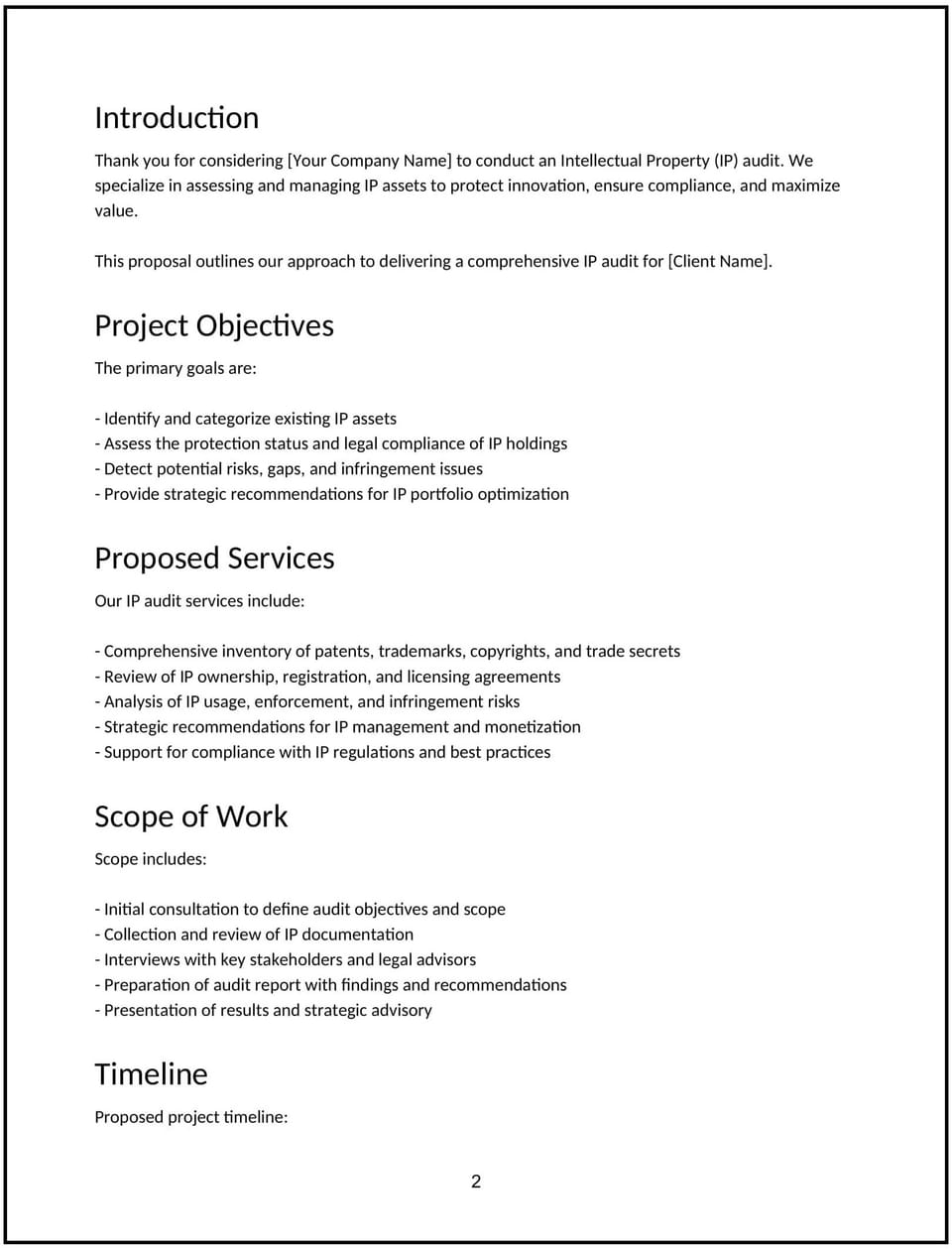Intellectual property audit proposal: Free template

Customize this free intellectual property audit proposal with Cobrief
Open this free intellectual property audit proposal in Cobrief and start editing it instantly using AI. You can adjust the tone, structure, and content based on your legal scope, the client’s industry, and the types of IP involved. You can also use AI to review your draft — highlight missing protections, clarify your process, and strengthen your positioning before sending.
Once you're done, send, download, or save the proposal in one click — no formatting or setup required.
This template is fully customizable and built for real-world use — ideal for startups, creative businesses, software companies, or any client with trademarks, copyrights, patents, or trade secrets. Whether you’re working as outside counsel or an independent consultant, this proposal helps you close work faster with a clear, professional structure.
What is an intellectual property audit proposal?
An intellectual property audit proposal outlines how you’ll assess a client’s IP portfolio, identify gaps or risks, and provide guidance on how to strengthen their protection strategy. It usually includes the scope of review, methodology, deliverables, pricing, and next steps.
This proposal is commonly used by IP lawyers, legal consultants, and compliance teams working with startups, growth-stage companies, or creative professionals. It often precedes product launches, investment rounds, licensing deals, or internal legal reviews.
Unlike a general legal services proposal, this version is focused specifically on evaluating the client’s intellectual property assets — and helping them manage legal and commercial risk accordingly.
Why use Cobrief to edit your proposal
- Edit the full proposal instantly: No formatting or uploads required — just open and customize.
- Use AI to tailor the content: Adjust tone, scope, and level of detail based on the client’s IP mix and goals.
- Run a full AI-powered review: Catch vague language, unclear deliverables, or missing details before sending.
- Apply edits in one click: Accept suggestions manually or automatically — section by section.
- Save, send, or download: Export your polished proposal instantly as a professional PDF.
When to use this proposal
- When helping a startup assess its IP before a product launch, fundraising round, or exit
- When advising a creative agency, SaaS company, or ecommerce brand on copyright or trademark protection
- When responding to an inquiry about licensing, brand enforcement, or portfolio cleanup
- When formalizing a scope of work after an initial consultation or discovery call
- When bundling IP audits with broader legal services or compliance reviews
What to include in an intellectual property audit proposal
- Project overview: Summarize the purpose of the audit — such as identifying gaps, reviewing registrations, assessing infringement risks, or preparing for due diligence. Tailor this based on the client’s goals and industry.
- Scope of work: List exactly what you’ll audit — e.g., trademarks, domain names, copyrights, patents, trade secrets, licensing agreements, and internal policies. Clarify whether international IP is included and how deep the review goes.
- Timeline: Provide a clear schedule from kickoff to final report delivery. Include milestones like data collection, review sessions, and client feedback rounds.
- Deliverables: Outline what the client will receive — such as an audit report, risk summary, recommended actions, and optional implementation support.
- Pricing: Present your fee as a fixed price, hourly rate, or phased structure. Include what’s covered in the price and clarify if additional filings, registrations, or enforcement support will be billed separately.
- Call to action / next steps: End with a clear prompt — e.g., approve the proposal, confirm scope, or schedule an onboarding session. Keep the tone professional and confident.
How to write an effective intellectual property audit proposal
- Match the language to the audience: Use plain language for founders or brand managers; use legal detail for in-house counsel.
- Emphasize business outcomes: Highlight how IP protection supports growth, valuation, or brand strength — not just compliance.
- Clarify what’s included: Define the boundaries of your audit clearly to avoid scope creep or misaligned expectations.
- Show your process: Outline how you’ll review and analyze the IP assets to build confidence and transparency.
- Keep the format tight: Use clear sections and bullets so clients can skim and understand the value quickly.
- Close with confidence: Always end with a CTA that moves the proposal toward approval.
Frequently asked questions (FAQs)
What types of IP are included in this audit?
You can include trademarks, copyrights, patents, trade secrets, domain names, licensing agreements, and more — just tailor the scope to the client’s business.
Can I offer implementation support after the audit?
Yes — you can include follow-up services like filing applications, sending takedown notices, or negotiating licenses as add-ons or separate engagements.
Is this suitable for early-stage companies with limited IP?
Absolutely. An IP audit is especially valuable for startups to identify what they have (or don’t), understand risks, and protect core assets early.
Can this proposal be used for international clients?
Yes — just update the jurisdictional scope in the proposal and clarify what regions your review covers.
Does this proposal act as a legal contract?
No — this outlines your services and pricing. You should follow up with a formal engagement letter or service agreement if required.
This article contains general legal information and does not contain legal advice. Cobrief is not a law firm or a substitute for an attorney or law firm. The law is complex and changes often. For legal advice, please ask a lawyer.